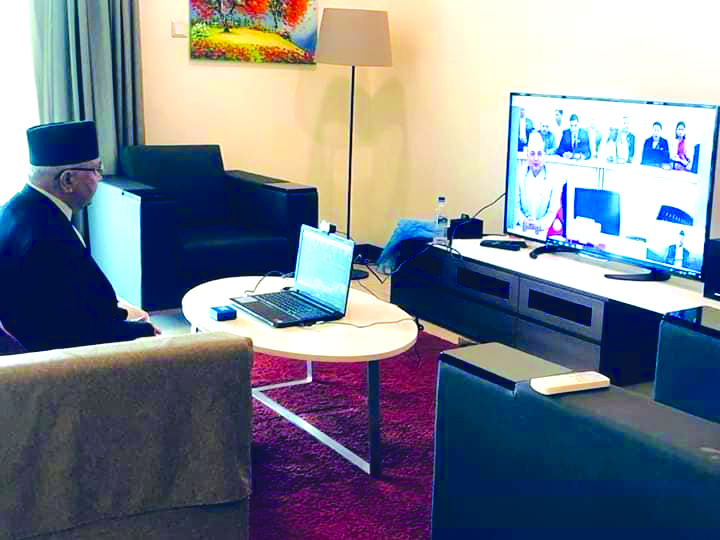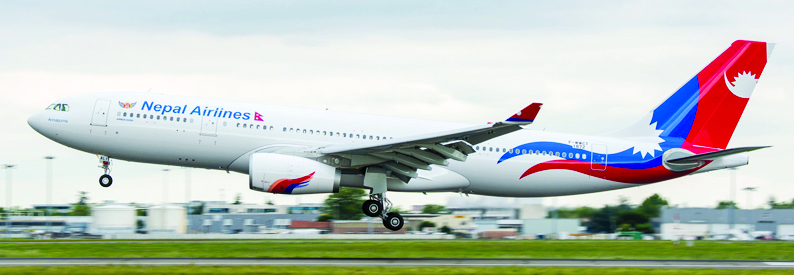COVID-19: Government resources in Nepal
1. The central lab at Sukraraj Tropical & Infectious Disease Hospital in Kathmandu is the only facility in Nepal to test COVID-19 infection.
2. Government has suspended visa-on-arrival for citizens from China, Iran, Italy, Korea, Japan, France, Germany, and Spain. Visitors from these countries also need to produce latest health certificate to come and they can enter the country only through the Tribhuvan International Airport.
3. International travelers are individually scrutinized at the TIA.
4. Health Minister Bhanu Bhakta Dhakal has asked people to ‘self-quarantine’ as per WHO recommendation, stating that the government cannot manage enough quarantine facilities for everyone.
5. Government has assigned 155 isolated beds in the Kathmandu Valley in 36 different hospitals, coordinated by seven ‘hub’ hospitals: Tribhuvan Army Hospital, TU Teaching Hospital, Bhaktapur Hospital, Bir Hospital, Civil Hospital, Patan Hospital, and Dhulikhel Hospital.
6. Cabinet has met four times on infection preparedness since the outbreak in Wuhan (till we went to press). An all-party meeting was also held.
7. A government focal body headed by deputy prime minister has been formed. Ministers for home affairs, education, health, tourism, industry, and finance are members.
8. In the provinces, a body chaired by the concerned chief minister or their representative will work as the focal body. Local elected officials will work as coordinators at local levels.
9. People have been asked to avoid mass meetings, conferences, and celebrations involving crowds
10. There are total 31,592 health professionals across Nepal under the Health Ministry, in addition to 52,000 women health workers.
A kidney transplant, and the corona scare
The executive head is ailing. PM KP Oli faces an uncertain recovery at the Tribhuvan University Teaching Hospital after a successful kidney transplant, his second. Next three months will be critical, as his body could still reject the new kidney in this time. The country he leads isn’t doing much better either. Its economy has been battered by the ever-growing fear of the entry of the dreaded coronavirus that has spread around the world from next-door China. A lot hinges on Oli’s recovery and the state’s handling of the coronavirus scare.
The ruling Nepal Communist Party remains bitterly divided nearly two years after the formal unity between the CPN-UML and the Maoists. Pushpa Kamal Dahal has never had to play second fiddle to anyone in the past three decades. But as a part of the party unification package deal, Dahal was forced into an uncomfortable compromise with Oli. As the undisputed leader of the NCP, Oli had slowly started consolidating power, both in the party and in the government. Now Dahal is getting antsy again. If he cannot be the prime minister right away, he would like to lock in the chairman’s position going into the general convention next April. Should Oli’s health remain iffy—or worse—Dahal will look to take complete control.
He won’t have it easy though. The one-time Maoist supremo will face a tough competition from ex-UML leaders who have never accepted Dahal as their chairman. But if Oli recovers well, all bets will be off, as he will again look to bolster his own claim for continued party leadership. Mischief-makers like Bamdev Gautam will get less room to play in that case.
Oli’s course of recovery will also have a direct ramification on whether the parliament endorses the MCC compact. The MCC folks in Kathmandu are having sleepless nights as Oli remains hospitalized; they are not banking on Dahal to see the project through. The Chinese may not be that perturbed at the prospect of Dahal becoming prime minister again. The Indians for their part will see political turmoil in Nepal as an opportunity to install their loyalists in the government, possibly with American help.
Meanwhile, even though no case of coronavirus has been reported in the country, the economy has still been hit hard as people are avoiding places with even a little crowd. If corona is detected tomorrow—which cannot be ruled out as the number of positives continue to rise in India—there could be a virtual curfew on the streets. In the absence of masks and medicines, panic will quickly spread. Once again, the biggest threats to Nepal emanate from outside the country.
But potentially destabilizing forces inside are as potent. The re-appointment of Yubaraj Khatiwada as finance minister has sent shock waves among the business community, as was reflected in the recent stock-market bloodbath. The economy is effectively rudderless at the hands of this cerebral finance minister who seems intent on charting his own socialist fiscal course. His questionable appointments notwithstanding, PM Oli will hopefully recover soon and take over the reins, and the worst of uncertainties can be avoided. The country is unstable even with him firmly in the fray. Without him, it will be anarchy.
South Korea embraces the BRI
On 26 December 2018, North and South Korea held ‘a groundbreaking ceremony’ to start a project to re-connect their railways and roads and to modernize North Korea’s old railway line. The two have also agreed to carry out a joint survey.
These developments are considered meaningful in North-East Asia as South Korea plans to extend its railway line to China and Russia, which will potentially have huge geopolitical impact in the region.
The blueprint for the ‘New Economic Initiative’ prepared by South Korea’s Ministry of Unification was shared with a group of international journalists in the last week of October.
It clearly mentions South Korea’s plan to connect with China’s Belt and Road Initiative (BRI) through North Korea. “We are seeking a new engine for economic growth and North Korea is focusing all its efforts on its construction industry, so we have given top priority to railway connectivity,” said officials at South Korea’s Ministry of Unification.
“The launch of the railway and road project also had symbolic meaning because it marked a starting point for [South Korean President] Moon’s proposal for the establishment of an East Asian rail network linking the Koreas with China, Russia and Mongolia,” wrote The Korea Times in its editorial published on 27 December 2018, a day after the ceremony. Since then, there have been several rounds of talks between the two Koreas about the railway line.
Officials say the ambitious railway line will be costly, although exact figures are not available yet. The Chinese province of Liaoning, which shares a border with North Korea, has already proposed a railway line connecting it with the North Korean capital Pyongyang and to extend it to Seoul under the BRI.
“This railway line will be costly, but it will be worth it,” said an official at South Korea’s Ministry of Foreign Affairs. The railway lines of the two Koreas remain largely broken since the Korean War (1950-1953). China and North Korea have also signed an agreement to link Dandong, a city in Liaoning Province, with Pyongyang with a high-speed rail line.
Experts say such developments will bring about significant changes in North-East Asia’s geopolitics. South Korean President Moon Jae-in has emphasized enhancing cooperation between the two Koreas since he assumed office in 2017. He has embraced a policy of greater engagement with North Korea amid lack of progress on denuclearization talks between Washington and Pyongyang.
Moon also came up with the ‘New Economic Initiative’, whose core and long-term objective is to connect with China’s BRI, Russia’s New Eastern Policy, and Mongolia’s Prairie Road Initiative. More than that, South Korea, which has a military alliance with the US, is willing to enhance cooperation with China in order to boost its economy, which is currently stagnant. Therefore, South Korea’s policy right now is to join the BRI by reconnecting its railway line with North Korea’s.
Chinese companies’ direct investment in South Korea surged 240 percent in 2018, according to the Ministry of Trade, Industry and Energy. China invested $2.74 billion in South Korea in 2018, up 238.9 percent from 2017 when China cut its investment by 60 percent. Chinese nationals also account for 31 percent of foreign visitors to South Korea, and South Korean officials say the railway line would help bring more tourists from China and increase other economic activities.
The main obstacle to implementing the ‘New Economic Initiative’ is the slow progress on denuclearization. Said another South Korean official, “Denuclearization can lead to huge economic cooperation between the two Koreas.”
WEEKLY APEX DIGEST
Thursday, August 22: The Cabinet amends rules allowing the prime minister to call cabinet meetings from abroad through a video conference.
Friday, August 23: The Supreme Court asks the federal government to come up with reasons behind the formulation of laws to provide monthly salary to all local level representatives.
Saturday, August 24: Minister of Labor, Employment and Social Security Gokarna Bista talks of how the implementation of the landmark social security scheme has hit roadblocks due to a lack of cooperation from industrialists.
Sunday, August 25: Minister of Information and Communication Technology Gokul Banskota assures his countrymen that the republican system is safe and secure.
Monday, August 26: The Supreme Court issues a verdict in Ncell’s favor in a case filed by the private telecom giant against the Large Taxpayers’ Office. Ncell was challenging the payment of Rs 62.63 billion in capital gain tax on its buyout deal.
Nepal Communist Party bars its cadres from criticizing its leaders, and for the first time in the country’s history its cabinet meeting was held through a video conference.

Tuesday, August 27: Chief Ministers of seven provinces express dissatisfaction over the tourism ministry’s preparations for Visit Nepal Year 2020.

Wednesday, August 28: Nepal Army says it will complete the Kathmandu-Nijgadh fast-track within the next three and a half years.
Thursday, August 29: The government tables the controversial Media Council Bill in the National Assembly. Ruling Nepal Communist Party has pledged to amend its controversial provisions as per the agreement with the Federation of Nepali Journalists.
Nepal Airlines’ A330 wide-body completes its maiden flight to Osaka, Japan. The airlines will fly to Osaka three times a week




















